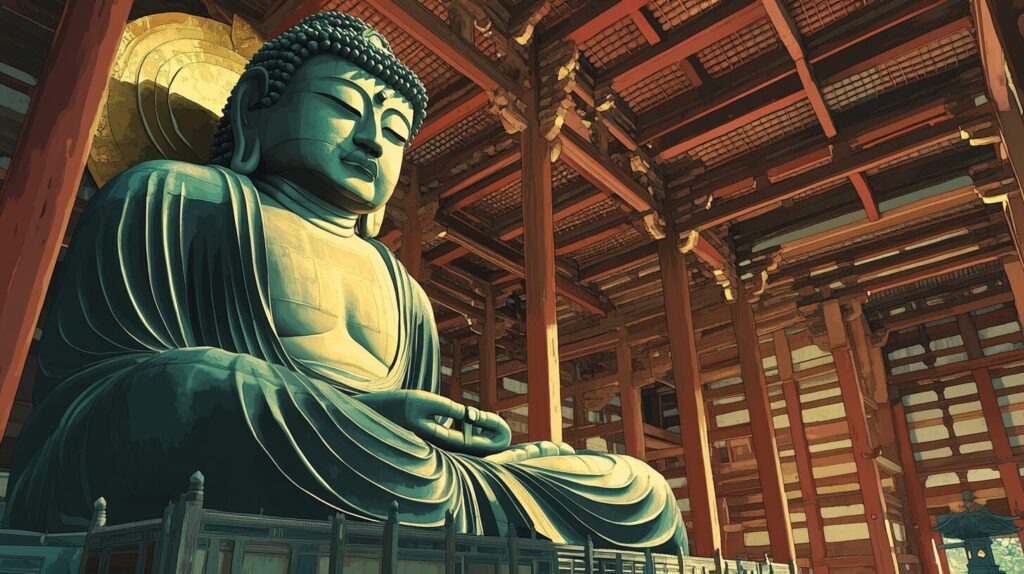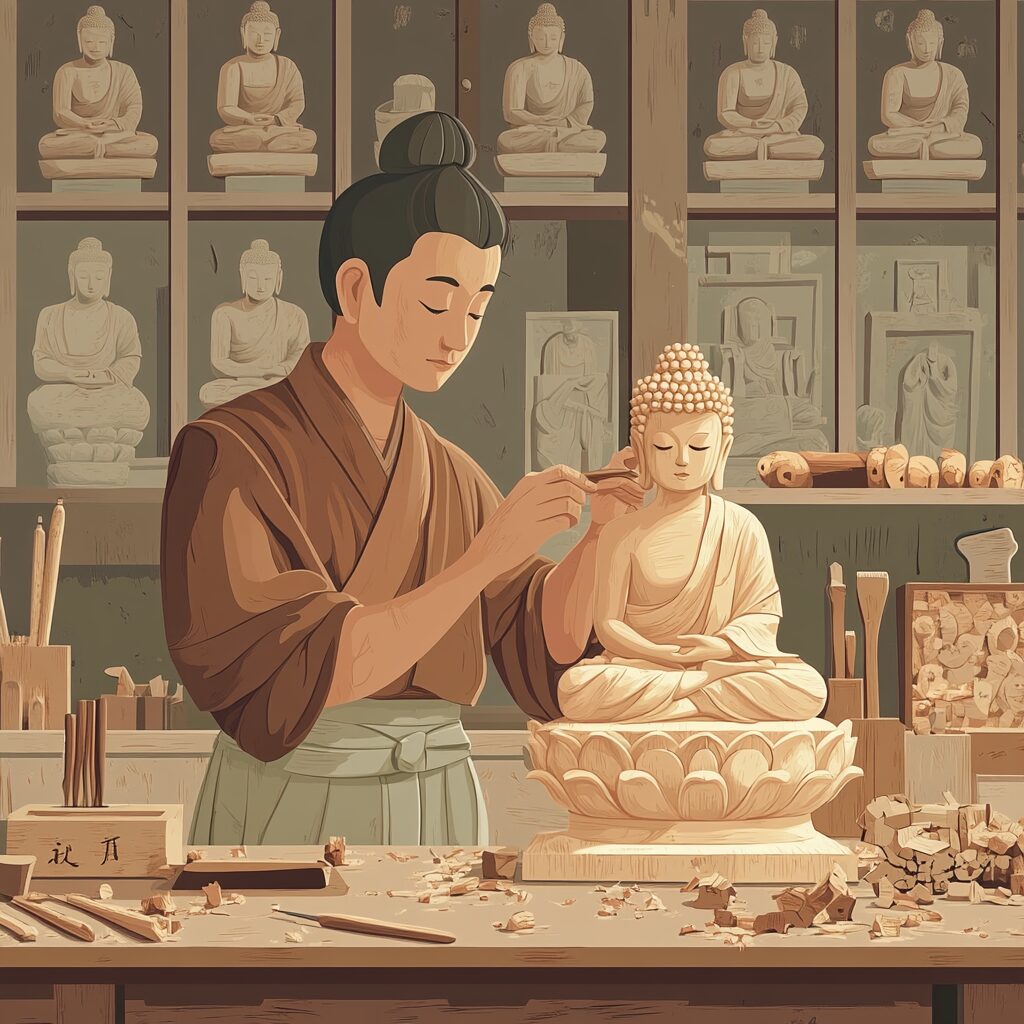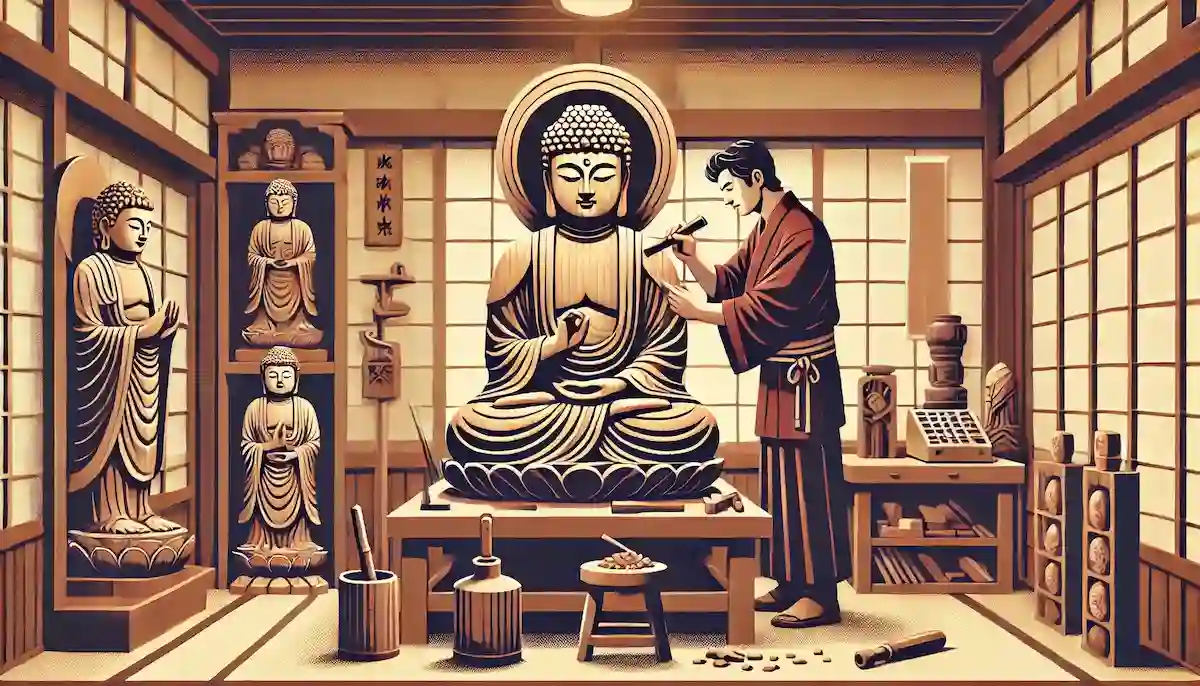仏像を英語で説明・紹介するための基本情報と、英会話に役立つ表現をシンプルでわかりやすい英語で紹介します。
英会話ダイアローグ・概要・10の質問を通して、仏像に関する英語表現を学びます。
英語
英会話ダイアローグを読む前に知っておくと良い前提知識と情報です。
- 仏像の4つの種類
- 如来: 悟りを開いた仏、特徴はシンプルな衣と穏やかな表情(例:奈良の大仏、阿弥陀如来)
- 菩薩: 人々を助ける仏、冠や装飾をつけた優雅な姿(例:観音菩薩、地蔵菩薩)
- 明王: 仏教を守る戦士のような存在、怒った顔や武器を持つことが多い(例:不動明王)
- 天部: 仏教の守護神、インドの神々が仏教に取り入れられたもの(例:毘沙門天)
- 時代区分と仏像
- 主要な仏像制作技法
- 木造 – 日本で最も一般的(例:平等院の阿弥陀如来)
- 青銅(鋳造仏) – 銅を溶かして型に流し込む(例:奈良の大仏)
- 寄木造 – 複数の木材を組み合わせる技法
- 乾漆 – 布と漆を重ねて作る(例:阿修羅像)
- 石仏 – 石を彫る(例:大谷石仏)
- 仏像の特徴と見分け方
- 手の形(印相)
- 施無畏印(せむいいん): 恐れを取り除く(奈良の大仏)
- 与願印(よがんいん): 願いを叶える
- 禅定印(ぜんじょういん): 瞑想のポーズ(阿弥陀如来)
- 持ち物
- 蓮(れんげ) : 清らかさを象徴(観音菩薩)
- 剣(つるぎ) : 無知を断ち切る(不動明王)
- 杖(つえ) : 旅人や子供を守る(地蔵菩薩)
- 手の形(印相)
- 有名な仏像
- 奈良の大仏/東大寺(奈良) : 世界最大級の青銅仏
- 鎌倉大仏/高徳院(神奈川) : 屋外にある巨大な阿弥陀如来
- 阿修羅像/興福寺(奈良) : 3つの顔と6本の腕、乾漆造
- 平等院阿弥陀如来/平等院(京都) : 優雅な寄木造の仏像
- 金剛力士像/東大寺南大門(奈良) : 力強い守護神、鎌倉時代の代表作
2人が仏像について話しています。
仏像の種類(如来・菩薩・明王・天部)の特徴や、飛鳥時代から鎌倉時代までの仏像様式の変遷などを話題にしています。
会話 / dialogue

Hey Key, I recently visited Tōdai-ji in Nara, and I was amazed by the Great Buddha. I didn’t know Buddhist statues were so fascinating!

That’s great! Buddhist statues are not just religious symbols; they also reflect history, art, and craftsmanship. Are you interested in learning more?

Yeah, definitely. I noticed different kinds of statues in the temple. How do you tell them apart?

Good question! Buddhist statues are mainly divided into four types: Nyorai (Buddhas), Bosatsu (Bodhisattvas), Myōō (Wisdom Kings), and Tenbu (Heavenly Beings).

So, the Great Buddha of Nara is a Nyorai, right?

Exactly! Nyorai statues represent enlightened Buddhas. They have simple robes, calm expressions, and no jewelry. Other examples are Shakyamuni Buddha and Amida Buddha.

What about Bosatsu? I think I saw some statues with crowns and elegant clothes.

Those are probably Bosatsu, or Bodhisattvas. They help others reach enlightenment, so they wear jewelry and fine robes to show their connection to the human world. Kannon and Jizō are famous Bosatsu.

And the ones with angry faces and weapons?

Those are Myōō (Wisdom Kings). They look fierce because they protect Buddhism from evil. Fudō Myōō, for example, holds a sword to cut through ignorance.

And Tenbu?

Tenbu are guardian deities, often from Hindu mythology. Bishamonten, for example, wears armor and protects Buddhist temples.

I see. Have Buddhist statues always looked the same?

No, their styles changed over time. In the Asuka period (6th–7th century), statues were small and made of bronze, influenced by China and Korea.

So, the Great Buddha of Nara is from the next period?

Yes! It’s from the Nara period (8th century), when giant bronze statues became popular. But later, in the Heian period (9th–12th century), wood became the main material, allowing for more elegant and delicate sculptures.

That’s interesting! So wooden statues appeared later?

Exactly! Heian-period statues, like the Amida Buddha at Byōdō-in, were carefully carved and had peaceful expressions. This was made possible by the Yosegi-zukuri (Joined-Wood) technique.

And what about the Kamakura period?

The Kamakura period (12th–14th century) focused on realism. Statues became more dynamic and expressive. Unkei and Kaikei, famous sculptors, made warrior-like figures like the Kongōrikishi guardian statues at Tōdai-ji.

That’s a huge change! Which period do you like best?

I love the Kamakura period because of its strong and lifelike expressions, but the elegant Heian statues are also beautiful. What about you?

I think the powerful presence of Nara-period statues impresses me, but I also like the craftsmanship of Kamakura ones.

That makes sense! If you want to see more, you should visit Kamakura Daibutsu, Ashura at Kōfuku-ji, and the statues at Hōryū-ji, which are from the Asuka period.

Wow, I have so many places to visit now! I never thought Buddhist statues could be this interesting.

I’m glad you think so! Let’s visit another temple next time. Maybe Hōryū-ji? It has some of the oldest Buddhist statues in Japan!
概要 / Overview
「仏像」について、理解を深めるための「英語での概要」です。
仏像

What Are Buddhist Statues?
Buddhist statues are sculptures that represent important figures in Buddhism. These statues are found in temples, shrines, and museums across Japan. They are not just religious symbols but also works of art that reflect history, culture, and craftsmanship. Many people visit temples to see these statues and learn about their meanings.
Types of Buddhist Statues
There are four main types of Buddhist statues:
•Nyorai (Buddhas): These statues show Buddhas who have reached enlightenment. They wear simple robes and have calm expressions. Examples include Shakyamuni Buddha and Amida Buddha.
•Bosatsu (Bodhisattvas): These statues represent beings who help others reach enlightenment. They wear crowns and jewelry. Famous ones include Kannon and Jizō.
•Myōō (Wisdom Kings): These fierce-looking statues protect Buddhism from evil. Fudō Myōō, for example, holds a sword to cut through ignorance.
•Tenbu (Heavenly Beings): These statues come from Hindu mythology and protect temples. Bishamonten is a well-known guardian deity.
How to Recognize Buddhist Statues
Each Buddhist statue has special features that help people recognize them.
•Hand Gestures (Mudras): Each hand position has a meaning. For example, the “Fearless Gesture” means protection, while the “Meditation Gesture” shows deep thought.
•Objects: Statues hold different objects. A lotus flower symbolizes purity, a sword represents wisdom, and a staff is used for guidance.
•Clothing and Expressions: Nyorai statues wear simple robes, Bosatsu have elegant clothes and jewelry, and Myōō have fierce expressions with weapons.
Materials and How They Are Made
Buddhist statues are made from different materials.
•Bronze: Used for large statues like the Great Buddha of Nara.
•Wood: Common in Japan, used for detailed carvings like the Amida Buddha at Byōdō-in.
•Stone: Found in outdoor carvings like the Ōya Stone Buddhas.
Famous Buddhist Statues in Japan
Some of the most famous Buddhist statues in Japan include:
•Great Buddha of Nara (Tōdai-ji): A 15-meter-tall bronze statue of Vairocana Buddha.
•Kamakura Daibutsu: A large outdoor Amida Buddha statue.
•Ashura Statue (Kōfuku-ji): A unique dry lacquer statue with three faces and six arms.
10の質問 / 10 questions
「仏像」について、理解を深めるための「英語での10の質問」です。
1: What is a Buddhist statue?
A Buddhist statue is a sculpture that represents important figures in Buddhism, such as Buddhas, Bodhisattvas, Wisdom Kings, and Heavenly Beings. These statues are found in temples and shrines in Japan.
2: What are the main types of Buddhist statues?
There are four main types: Nyorai (Buddhas), Bosatsu (Bodhisattvas), Myōō (Wisdom Kings), and Tenbu (Heavenly Beings). Each type has a different role and appearance.
3: How can you recognize a Nyorai statue?
Nyorai statues have simple robes, no jewelry, and a calm expression. They represent Buddhas who have reached enlightenment. Famous examples include Shakyamuni Buddha and Amida Buddha.
4: What is special about Bosatsu statues?
Bosatsu statues represent beings who help others reach enlightenment. They wear elegant clothes and jewelry, showing their connection to the human world. Kannon and Jizō are well-known Bosatsu.
5: Why do some Buddhist statues have angry faces?
These are Myōō (Wisdom Kings). They look fierce because they protect Buddhism from evil. Fudō Myōō, for example, holds a sword to cut through ignorance.
6: What materials are used to make Buddhist statues?
Buddhist statues are made from various materials, including bronze, wood, stone, clay, and dry lacquer. The material used depends on the period and style of the statue.
7: How did Buddhist statue styles change over time?
In the Asuka period, statues were small and influenced by China and Korea. In the Nara period, large bronze statues became popular. The Heian period introduced elegant wooden statues, and the Kamakura period focused on realistic, dynamic sculptures.
8: What is a famous Buddhist statue in Japan?
The Great Buddha of Nara at Tōdai-ji is one of the most famous statues. It is a 15-meter-tall bronze statue of Vairocana Buddha, built in the 8th century.
9: What is the Yosegi-zukuri technique?
Yosegi-zukuri is a wood-carving technique used in Japan. Instead of carving from a single block, sculptors join multiple pieces of wood together. This method allows for larger and more detailed statues.
10: Why do people visit Buddhist statues in Japan?
People visit Buddhist statues for religious reasons, to pray for good fortune or protection. Others visit to appreciate their historical and artistic value, as many statues are important cultural treasures.

和訳付
会話 / dialogue

Hey Key, I recently visited Tōdai-ji in Nara, and I was amazed by the Great Buddha. I didn’t know Buddhist statues were so fascinating!
キー、この前奈良の東大寺に行ったんだけど、大仏にすごく感動したよ。仏像がこんなに面白いなんて知らなかった!

That’s great! Buddhist statues are not just religious symbols; they also reflect history, art, and craftsmanship. Are you interested in learning more?
それはいいね!仏像は単なる宗教的なシンボルじゃなくて、歴史や美術、職人技の結晶でもあるんだよ。もっと知りたくない?

Yeah, definitely. I noticed different kinds of statues in the temple. How do you tell them apart?
うん、ぜひ知りたい!寺の中にいろいろな種類の仏像があったけど、どうやって見分けるの?

Good question! Buddhist statues are mainly divided into four types: Nyorai (Buddhas), Bosatsu (Bodhisattvas), Myōō (Wisdom Kings), and Tenbu (Heavenly Beings).
いい質問だね!仏像は大きく分けて如来、菩薩、明王、天部の4種類があるよ。

So, the Great Buddha of Nara is a Nyorai, right?
じゃあ、奈良の大仏は如来なんだよね?

Exactly! Nyorai statues represent enlightened Buddhas. They have simple robes, calm expressions, and no jewelry. Other examples are Shakyamuni Buddha and Amida Buddha.
その通り!如来は悟りを開いた仏を表しているんだ。特徴はシンプルな衣、穏やかな表情、装飾なしってところかな。他には釈迦如来や阿弥陀如来が有名だよ。

What about Bosatsu? I think I saw some statues with crowns and elegant clothes.
じゃあ、菩薩は?冠をかぶって、豪華な服を着ている仏像を見た気がするけど。

Those are probably Bosatsu, or Bodhisattvas. They help others reach enlightenment, so they wear jewelry and fine robes to show their connection to the human world. Kannon and Jizō are famous Bosatsu.
それはきっと菩薩だね。彼らはまだ悟りを開いていなくて、人々を救うためにこの世に留まっているんだ。そのために、宝飾や豪華な衣を身につけて、人々とのつながりを示しているんだよ。観音菩薩や地蔵菩薩が有名だね。

And the ones with angry faces and weapons?
じゃあ、怒った顔で武器を持っている仏像は?

Those are Myōō (Wisdom Kings). They look fierce because they protect Buddhism from evil. Fudō Myōō, for example, holds a sword to cut through ignorance.
それは明王だね。彼らは仏教を悪から守るために、あえて恐ろしい表情をしているんだ。例えば、不動明王は剣を持っていて、無知を断ち切る象徴なんだよ。

And Tenbu?
じゃあ、天部は?

Tenbu are guardian deities, often from Hindu mythology. Bishamonten, for example, wears armor and protects Buddhist temples.天部は仏教を守る神々で、もともとはヒンドゥー教の神々が仏教に取り入れられたものなんだ。例えば、毘沙門天(びしゃもんてん)は鎧を着て、お寺を守る役割があるんだよ。

I see. Have Buddhist statues always looked the same?
なるほど。でも、仏像って昔からずっと同じデザインなの?

No, their styles changed over time. In the Asuka period (6th–7th century), statues were small and made of bronze, influenced by China and Korea.
いや、時代ごとに変化してきたよ。飛鳥時代(6~7世紀)は、仏像は小さくて青銅製のものが多く、中国や朝鮮の影響を強く受けていたんだ。

So, the Great Buddha of Nara is from the next period?
じゃあ、奈良の大仏はその次の時代?

Yes! It’s from the Nara period (8th century), when giant bronze statues became popular. But later, in the Heian period (9th–12th century), wood became the main material, allowing for more elegant and delicate sculptures.
そう!奈良時代(8世紀)には、巨大な青銅の仏像が流行したんだ。 でもその後、平安時代(9~12世紀)になると、木造が主流になって、より優雅で繊細な仏像が作られるようになったんだよ。

That’s interesting! So wooden statues appeared later?
面白いな!じゃあ、木造の仏像はあとから出てきたんだね?

Exactly! Heian-period statues, like the Amida Buddha at Byōdō-in, were carefully carved and had peaceful expressions. This was made possible by the Yosegi-zukuri (Joined-Wood) technique.
その通り!平安時代の仏像、例えば平等院の阿弥陀如来は、繊細に彫られていて、とても穏やかな表情をしている。 これは寄木造という技術のおかげなんだ。

And what about the Kamakura period?
じゃあ、鎌倉時代は?

The Kamakura period (12th–14th century) focused on realism. Statues became more dynamic and expressive. Unkei and Kaikei created warrior-like statues like Kongōrikishi at Tōdai-ji.
鎌倉時代(12~14世紀)は、リアリズムが重視された。 仏像はよりダイナミックで表情豊かになったんだ。特に運慶と快慶は、東大寺の金剛力士像みたいな力強い仏像を作ったよ。

That’s a huge change! Which period do you like best?
すごい変化だね!キーはどの時代の仏像が一番好き?

I love the Kamakura period because of its strong and lifelike expressions, but the elegant Heian statues are also beautiful. What about you?
鎌倉時代の仏像が好きかな。力強くてリアルな表情が魅力的なんだ。でも、平安時代の優雅な仏像も美しくていいよね。マックはどう?

I think the powerful presence of Nara-period statues impresses me, but I also like the craftsmanship of Kamakura ones.
僕は奈良時代の仏像の迫力に圧倒されたけど、鎌倉時代の仏像の職人技もすごく魅力的だと思うな。

That makes sense! If you want to see more, you should visit Kamakura Daibutsu, Ashura at Kōfuku-ji, and the statues at Hōryū-ji, which are from the Asuka period.
それ、わかるよ!もっといろいろ見たいなら、鎌倉大仏、興福寺の阿修羅像、そして飛鳥時代の仏像が残る法隆寺にも行ってみるといいよ。

Wow, I have so many places to visit now! I never thought Buddhist statues could be this interesting.
うわぁ、行きたい場所がいっぱいできた!仏像がこんなに面白いなんて思わなかったよ。

I’m glad you think so! Let’s visit another temple next time. Maybe Hōryū-ji? It has some of the oldest Buddhist statues in Japan!
そう思ってもらえて嬉しいよ!じゃあ、今度またお寺に行こうよ。法隆寺はどう?日本最古級の仏像が見られるよ!
概要 / Overview
仏像

What Are Buddhist Statues?
Buddhist statues are sculptures that represent important figures in Buddhism. These statues are found in temples, shrines, and museums across Japan. They are not just religious symbols but also works of art that reflect history, culture, and craftsmanship. Many people visit temples to see these statues and learn about their meanings.
仏像とは何か?
仏像は、仏教の重要な人物を表す彫刻です。これらの仏像は、日本中の寺院や神社、美術館などで見ることができます。仏像は単なる宗教的なシンボルではなく、歴史や文化、職人技を反映した芸術作品でもあります。多くの人が寺院を訪れ、仏像を見てその意味を学んでいます。
Types of Buddhist Statues
There are four main types of Buddhist statues:
•Nyorai (Buddhas): These statues show Buddhas who have reached enlightenment. They wear simple robes and have calm expressions. Examples include Shakyamuni Buddha and Amida Buddha.
•Bosatsu (Bodhisattvas): These statues represent beings who help others reach enlightenment. They wear crowns and jewelry. Famous ones include Kannon and Jizō.
•Myōō (Wisdom Kings): These fierce-looking statues protect Buddhism from evil. Fudō Myōō, for example, holds a sword to cut through ignorance.
•Tenbu (Heavenly Beings): These statues come from Hindu mythology and protect temples. Bishamonten is a well-known guardian deity.
仏像の種類
仏像には、主に4つの種類があります。
•如来: 悟りを開いた仏を表します。シンプルな衣をまとい、穏やかな表情をしています。代表的なものに、釈迦如来や阿弥陀如来があります。
•菩薩: 人々を悟りへ導く存在です。冠や宝飾を身につけています。代表的なものは、観音菩薩や地蔵菩薩です。
•明王: 仏教を守るため、怒った表情をしています。例えば、不動明王は剣を持ち、無知を断ち切る力を象徴しています。
•天部: 仏教を守る神々で、ヒンドゥー教から取り入れられました。毘沙門天は有名な守護神の一つです。
How to Recognize Buddhist Statues
Each Buddhist statue has special features that help people recognize them.
•Hand Gestures (Mudras): Each hand position has a meaning. For example, the “Fearless Gesture” means protection, while the “Meditation Gesture” shows deep thought.
•Objects: Statues hold different objects. A lotus flower symbolizes purity, a sword represents wisdom, and a staff is used for guidance.
•Clothing and Expressions: Nyorai statues wear simple robes, Bosatsu have elegant clothes and jewelry, and Myōō have fierce expressions with weapons.
仏像の見分け方
仏像には、それぞれ見分けるための特徴があります。
•手の形(印相): 手のポーズには意味があります。例えば、「施無畏印」は守護を表し、「禅定印」は深い瞑想を意味します。
•持ち物: 仏像が持っている物にも意味があります。蓮の花は清らかさ、剣は知恵、杖は導きを象徴します。
•服装や表情: 如来はシンプルな衣装, 菩薩は優雅な服と宝飾, 明王は怒った表情と武器を持つことが多いです。
Materials and How They Are Made
Buddhist statues are made from different materials.
•Bronze: Used for large statues like the Great Buddha of Nara.
•Wood: Common in Japan, used for detailed carvings like the Amida Buddha at Byōdō-in.
•Stone: Found in outdoor carvings like the Ōya Stone Buddhas.
仏像の材質と作り方
仏像はさまざまな材料で作られます。
•青銅: 奈良の大仏のような大型仏像に使われます。
•木造: 日本では最も一般的で、平等院の阿弥陀如来のように細かい彫刻が可能です。
•石仏: 屋外にある石の仏像で、大谷石仏などが有名です。
Famous Buddhist Statues in Japan
Some of the most famous Buddhist statues in Japan include:
•Great Buddha of Nara (Tōdai-ji): A 15-meter-tall bronze statue of Vairocana Buddha.
•Kamakura Daibutsu: A large outdoor Amida Buddha statue.
•Ashura Statue (Kōfuku-ji): A unique dry lacquer statue with three faces and six arms.
日本国内の有名な仏像
日本には、以下のような有名な仏像があります。
•奈良の大仏(東大寺): 高さ15メートルの盧舎那仏で、日本最大の青銅製仏像。
•鎌倉大仏(高徳院): 屋外にある大きな阿弥陀如来像。
•阿修羅像(興福寺): 三つの顔と六本の腕を持つ、乾漆造の珍しい仏像。
10の質問 / 10 questions
1: What is a Buddhist statue?
仏像とは何ですか?
A Buddhist statue is a sculpture that represents important figures in Buddhism, such as Buddhas, Bodhisattvas, Wisdom Kings, and Heavenly Beings. These statues are found in temples and shrines in Japan.
仏像とは、仏教の重要な存在を表す彫刻のことです。仏や菩薩、明王、天部の神々などが含まれます。これらの仏像は、日本の寺院や神社で見ることができます。
2: What are the main types of Buddhist statues?
仏像の主な種類は何ですか?
There are four main types: Nyorai (Buddhas), Bosatsu (Bodhisattvas), Myōō (Wisdom Kings), and Tenbu (Heavenly Beings). Each type has a different role and appearance.
仏像には主に4つの種類があります。如来(仏)、菩薩、明王、天部です。それぞれ役割や見た目が異なります。
3: How can you recognize a Nyorai statue?
如来の仏像はどのように見分けられますか?
Nyorai statues have simple robes, no jewelry, and a calm expression. They represent Buddhas who have reached enlightenment. Famous examples include Shakyamuni Buddha and Amida Buddha.
如来の仏像は、シンプルな衣をまとい、装飾をつけず、穏やかな表情をしています。これは悟りを開いた仏を表しており、有名な例としては釈迦如来や阿弥陀如来があります。
4: What is special about Bosatsu statues?
菩薩の仏像の特徴は何ですか?
Bosatsu statues represent beings who help others reach enlightenment. They wear elegant clothes and jewelry, showing their connection to the human world. Kannon and Jizō are well-known Bosatsu.
菩薩の仏像は、人々が悟りに到達するのを助ける存在を表しています。優雅な服や装飾を身につけており、人間界とのつながりを示しています。有名な菩薩には観音菩薩や地蔵菩薩があります。
5: Why do some Buddhist statues have angry faces?
なぜ一部の仏像は怒った顔をしているのですか?
These are Myōō (Wisdom Kings). They look fierce because they protect Buddhism from evil. Fudō Myōō, for example, holds a sword to cut through ignorance.
それらは明王の仏像です。彼らは仏教を悪から守るために、怖い表情をしています。例えば、不動明王は剣を持ち、無知を断ち切る力を象徴しています。
6: What materials are used to make Buddhist statues?
仏像はどのような材料で作られていますか?
Buddhist statues are made from various materials, including bronze, wood, stone, clay, and dry lacquer. The material used depends on the period and style of the statue.
仏像は、青銅、木、石、粘土、乾漆など、さまざまな材料で作られます。使用される材料は、時代や仏像のスタイルによって異なります。
7: How did Buddhist statue styles change over time?
仏像のスタイルは時代とともにどのように変化しましたか?
In the Asuka period, statues were small and influenced by China and Korea. In the Nara period, large bronze statues became popular. The Heian period introduced elegant wooden statues, and the Kamakura period focused on realistic, dynamic sculptures.
飛鳥時代には、仏像は小さく、中国や朝鮮の影響を受けていました。奈良時代には、大型の青銅仏が流行しました。平安時代には優雅な木造仏が登場し、鎌倉時代にはリアルで躍動感のある仏像が作られるようになりました。
8: What is a famous Buddhist statue in Japan?
日本の有名な仏像は何ですか?
The Great Buddha of Nara at Tōdai-ji is one of the most famous statues. It is a 15-meter-tall bronze statue of Vairocana Buddha, built in the 8th century.
奈良の東大寺にある奈良の大仏は、日本で最も有名な仏像の一つです。これは、高さ15メートルの盧舎那仏で、8世紀に建てられました。
9: What is the Yosegi-zukuri technique?
寄木造とは何ですか?
Yosegi-zukuri is a wood-carving technique used in Japan. Instead of carving from a single block, sculptors join multiple pieces of wood together. This method allows for larger and more detailed statues.
寄木造は、日本で使われる木彫技法の一つです。一つの木から彫るのではなく、複数の木のパーツを組み合わせて作ります。この技法により、大型で細かい彫刻が可能になります。
10: Why do people visit Buddhist statues in Japan?
なぜ日本では仏像を訪れる人が多いのですか?
People visit Buddhist statues for religious reasons, to pray for good fortune or protection. Others visit to appreciate their historical and artistic value, as many statues are important cultural treasures.
人々は宗教的な理由で仏像を訪れ、幸運や守護を祈ることが多いです。また、多くの仏像は文化財としても重要であり、歴史や芸術を楽しむために訪れる人もいます。

words & phrases
英会話ダイアローグと関連情報に出てきた単語・フレーズです(例文は各3つ)。

religious : 形容詞
意味: 宗教の、信仰の。Related to religion or belief in a god or gods.
(仏像が単なる芸術作品ではなく、信仰の対象であることを説明する際に使用)
例文:
- Many people visit temples for religious reasons.
「多くの人が宗教的な理由で寺院を訪れます。」 - The Great Buddha of Nara is an important religious symbol.
「奈良の大仏は重要な宗教的シンボルです。」 - She comes from a very religious family.
「彼女はとても信仰深い家庭の出身です。」
craftsmanship : 名詞
意味: 職人技、技術。The skill and quality of making something, especially by hand.
(仏像が職人の高度な技術によって作られていることを説明する際に使用)
例文:
- The craftsmanship of Buddhist statues is amazing.
「仏像の職人技は驚くべきものです。」 - This temple is famous for the fine craftsmanship of its wooden carvings.
「この寺は、木彫りの精巧な職人技で有名です。」 - Traditional Japanese craftsmanship is highly valued worldwide.
「日本の伝統的な職人技は世界的に高く評価されています。」
enlightenment : 名詞
意味: 悟り、啓発。The state of gaining spiritual knowledge and wisdom, often used in Buddhism.
(如来の仏像が悟りを開いた存在であることを説明する際に使用)
例文:
- Buddha achieved enlightenment under the Bodhi tree.
「ブッダは菩提樹の下で悟りを開きました。」 - Many people meditate to seek enlightenment.
「多くの人が悟りを求めて瞑想をします。」 - The path to enlightenment requires deep understanding and patience.
「悟りへの道は深い理解と忍耐を必要とします。」
fierce : 形容詞
意味: 激しい、荒々しい。Very strong, powerful, or aggressive.
(明王の仏像が敵を打ち破るために恐ろしい表情をしていることを説明する際に使用)
例文:
- The statue of Fudō Myōō has a fierce expression.
「不動明王の仏像は激しい表情をしています。」 - He gave me a fierce look when I made a mistake.
「私がミスをしたとき、彼は激しい表情で私を見ました。」 - The warriors fought a fierce battle.
「戦士たちは激しい戦いを繰り広げました。」
sculptor : 名詞
意味: 彫刻家。A person who creates sculptures by carving or shaping materials.
(仏像を作る職人(運慶・快慶など)について説明する際に使用)
例文:
- Unkei was a famous sculptor in the Kamakura period.
「運慶は鎌倉時代の有名な彫刻家でした。」 - The sculptor carefully carved the details of the Buddha’s face.
「彫刻家は仏の顔の細部を丁寧に彫りました。」 - Michelangelo was a great sculptor of the Renaissance.
「ミケランジェロはルネサンス期の偉大な彫刻家でした。」
